

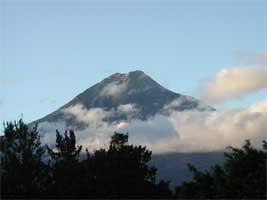 |
Volcano Agua, Guatemala.
|
sabbatical | marc | mountains | masses | mujeres
I grew up on the flat eastern plains of South Dakota. I love mountains, and still have vivid dreams that somehow mountains grew up around our farm. What more can I say?
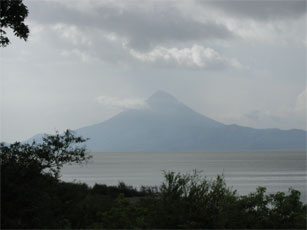 Monotombo Volcano, Nicaragua. A perfect cone shaped volcano that when it errupts can do a lot of damage.
Monotombo Volcano, Nicaragua. A perfect cone shaped volcano that when it errupts can do a lot of damage.
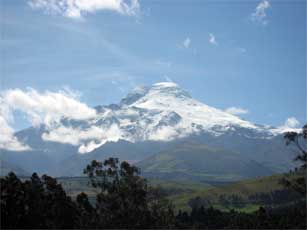 Cayambe Volcano, Ecuador. The equator crosses the snow fields on the southern (righthand side in this photo) slopes of Cayambe, its highest point as it circles the earth. Once thought to be dead, we now know that it is merely dormant and could threaten to come back to life.
Cayambe Volcano, Ecuador. The equator crosses the snow fields on the southern (righthand side in this photo) slopes of Cayambe, its highest point as it circles the earth. Once thought to be dead, we now know that it is merely dormant and could threaten to come back to life.
Mount Cameroon or Fako is the tallest mountain in West Africa. I saw it out the back window of a cab as we left for the airport in Douala. I should have taken a picture.
 The snows of Mt. Kilimanjaro are of the top 100 things to do in a lifetime. According to Al Gore in An Inconvenient Truth, global warming will probably make the snow disappear entirely within the next ten years. So, catch them while you can. The classic safari photo is an elephant in front of Mt. Kilimanjaro. Cheryl looks at the the elephant. I can see one in a zoo. There is no other way to see the snows of Mt. Kilimanjaro except to come to East Africa. (See video clips of the elephants and lions.)
The snows of Mt. Kilimanjaro are of the top 100 things to do in a lifetime. According to Al Gore in An Inconvenient Truth, global warming will probably make the snow disappear entirely within the next ten years. So, catch them while you can. The classic safari photo is an elephant in front of Mt. Kilimanjaro. Cheryl looks at the the elephant. I can see one in a zoo. There is no other way to see the snows of Mt. Kilimanjaro except to come to East Africa. (See video clips of the elephants and lions.)
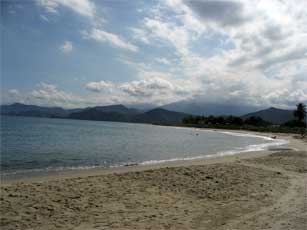 Mountains form an escarpment along Venezuela's northern coast. Often shrouded in clouds from the moist Caribbean air, they rise up behind the beach. I wanted to climb back into these mountains, but instead got stuck on the beach where everything gets full of sand, my glasses get covered with salt water, and I cut my foot on the rocks trying to walk around Isla Larga.
Mountains form an escarpment along Venezuela's northern coast. Often shrouded in clouds from the moist Caribbean air, they rise up behind the beach. I wanted to climb back into these mountains, but instead got stuck on the beach where everything gets full of sand, my glasses get covered with salt water, and I cut my foot on the rocks trying to walk around Isla Larga.
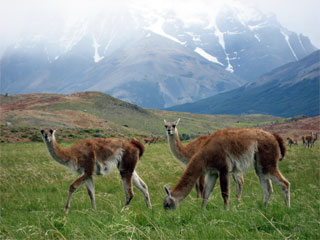 If the classic safari photo is an elephant in front of Mount Kilimanjaro, is the classic Chile photo a guanaco in front of Torres de Paine? The mountains are clouded in, so we really can't see them anyway (which is a big disappointment). The guanacos, however, were pretty cool. They are one of four members of the Andean cameloid family (the others being the llama, alpaca, and vicuña). And we have a video clip of a guanaco! (and penguins!)
If the classic safari photo is an elephant in front of Mount Kilimanjaro, is the classic Chile photo a guanaco in front of Torres de Paine? The mountains are clouded in, so we really can't see them anyway (which is a big disappointment). The guanacos, however, were pretty cool. They are one of four members of the Andean cameloid family (the others being the llama, alpaca, and vicuña). And we have a video clip of a guanaco! (and penguins!)
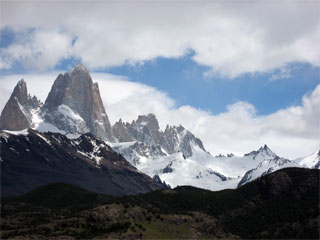 Farther north up is the equally spectacular Fitz Roy range on the Argentine side of the border that runs down the spine of the Andes mountains. The park service says that it is cloudy about 5 days a week. If it were sunny more often, glaciers that dot the Andes would all melt. The clouds, however, mean that glimpses of the mountain peaks are not all that common. Late in the afternoon, the clouds lift a bit and through them I catch a fleeting glimpse of the Fitz Roy peak (more properly known by its aboriginal name Chalten). It is windy and cold with specks of snow flying through the air, but the mountains are beautiful. (Video clips of a condor, sea lions, and a calving Glacier Moreno.)
Farther north up is the equally spectacular Fitz Roy range on the Argentine side of the border that runs down the spine of the Andes mountains. The park service says that it is cloudy about 5 days a week. If it were sunny more often, glaciers that dot the Andes would all melt. The clouds, however, mean that glimpses of the mountain peaks are not all that common. Late in the afternoon, the clouds lift a bit and through them I catch a fleeting glimpse of the Fitz Roy peak (more properly known by its aboriginal name Chalten). It is windy and cold with specks of snow flying through the air, but the mountains are beautiful. (Video clips of a condor, sea lions, and a calving Glacier Moreno.)
 I'm not sure that Uruguay has mountains? At least Montevideo does not. But its shoreline does have wide, white-sand beaches. And it is hot. We've gone from the cold and wet southern Patagonia weather to Montevideo's subtropical climate.
I'm not sure that Uruguay has mountains? At least Montevideo does not. But its shoreline does have wide, white-sand beaches. And it is hot. We've gone from the cold and wet southern Patagonia weather to Montevideo's subtropical climate.
 Much like Uruguay, The Netherlands (i.e., the "low countries")--much of which lays below sea level--does not have much for mountains. The joke is that the Dutch Alps are in Germany. What it does have, though, are canals. Lots of them. Especially in Amsterdam. So, what if we substitute a canal for a mountain?
Much like Uruguay, The Netherlands (i.e., the "low countries")--much of which lays below sea level--does not have much for mountains. The joke is that the Dutch Alps are in Germany. What it does have, though, are canals. Lots of them. Especially in Amsterdam. So, what if we substitute a canal for a mountain?
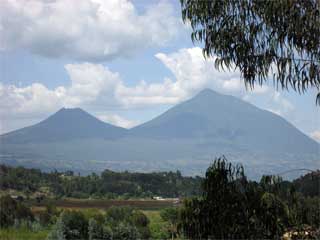 Finally in Rwanda we are back into volcano territory. The country has a row of volcanos on the northeast border with the Democratic Republic of Congo. This is where gorillas hang out. We spend the first week in this area, but it always seemed to be to cloudy to see them. The second week, we drove back through the area to visit coffee cooperatives. I shot a bunch of pictures from a distance in the morning when the sky was clear, but they were from a car bouncing over bad roads. I thought I would have to settle for one of those pictures. In the aternoon with the clouds already coming in, we approached the volcanos and then started to drive away. Finally, I asked to stop to grab a quick picture. It would be so fun to climb them.
Finally in Rwanda we are back into volcano territory. The country has a row of volcanos on the northeast border with the Democratic Republic of Congo. This is where gorillas hang out. We spend the first week in this area, but it always seemed to be to cloudy to see them. The second week, we drove back through the area to visit coffee cooperatives. I shot a bunch of pictures from a distance in the morning when the sky was clear, but they were from a car bouncing over bad roads. I thought I would have to settle for one of those pictures. In the aternoon with the clouds already coming in, we approached the volcanos and then started to drive away. Finally, I asked to stop to grab a quick picture. It would be so fun to climb them.
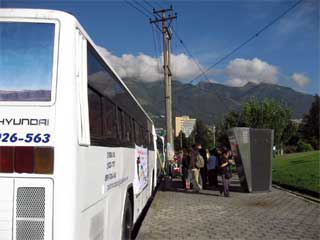 After three days of meetings against military bases at the Catholic University, under the shadow of the Pichincha volcano we climb on six buses for the Women for Peace Caravan against military bases, war, and militarism from Quito to Manta. The weather has been cool and cloudy and Quito's air becomes very polluted, so we don't get very clear views of the surrounding mountains. The ride through the rainforest on the western slopes of the Andes down to the coast, though, is incredibly beautiful. It has been years since I've come this way, and I've forgotten how scenic it is.
After three days of meetings against military bases at the Catholic University, under the shadow of the Pichincha volcano we climb on six buses for the Women for Peace Caravan against military bases, war, and militarism from Quito to Manta. The weather has been cool and cloudy and Quito's air becomes very polluted, so we don't get very clear views of the surrounding mountains. The ride through the rainforest on the western slopes of the Andes down to the coast, though, is incredibly beautiful. It has been years since I've come this way, and I've forgotten how scenic it is.
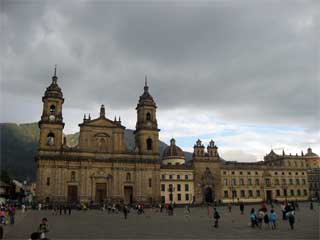 As I noted in Rwanda, I had always thought of Colombia as a violent country and did not realize how beautiful it was until I visited. Looking at my pictures, I must again be so focused on the political situation that I missed the natural beauty around me. People mentioned beautiful mountains to me, including one in Santa Marta that rises from the Caribbean Sea to a height of almost 6000 meters. I did not have time to visit. Maybe some other time. The capital city of Bogotá is nestled in a mountain valley. From the main square of Plaza Bolívar, mountains are visible behind the cathedral. The air is not nearly as poluted as that of Quito, and it is a beautiful view.
As I noted in Rwanda, I had always thought of Colombia as a violent country and did not realize how beautiful it was until I visited. Looking at my pictures, I must again be so focused on the political situation that I missed the natural beauty around me. People mentioned beautiful mountains to me, including one in Santa Marta that rises from the Caribbean Sea to a height of almost 6000 meters. I did not have time to visit. Maybe some other time. The capital city of Bogotá is nestled in a mountain valley. From the main square of Plaza Bolívar, mountains are visible behind the cathedral. The air is not nearly as poluted as that of Quito, and it is a beautiful view.
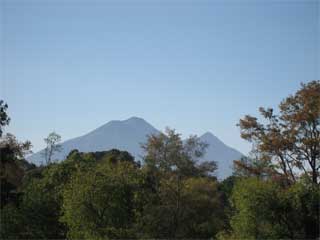 Back in Guatemala, it briefly appeared that I might finally be able to climb a volcano. Iximche' sits on a plateau, and the surrounding volcanoes peak through the trees. At first the sky is beautifully blue and clear, and I begin to think about making an assault on Agua. I snap a couple pictures, but do not give it much thought. Surely later I will be in a more advantageous position to capture the volcanoes. But then clouds move in, and the volcanoes disappear. I begin to let go of my plans to climb a volcano. But the morning of the last day, the clouds lift and another bright, beautiful day dawns. I kick myself for not going ahead with plans for the climb. It would have been nice to bring things back around full circle.
Back in Guatemala, it briefly appeared that I might finally be able to climb a volcano. Iximche' sits on a plateau, and the surrounding volcanoes peak through the trees. At first the sky is beautifully blue and clear, and I begin to think about making an assault on Agua. I snap a couple pictures, but do not give it much thought. Surely later I will be in a more advantageous position to capture the volcanoes. But then clouds move in, and the volcanoes disappear. I begin to let go of my plans to climb a volcano. But the morning of the last day, the clouds lift and another bright, beautiful day dawns. I kick myself for not going ahead with plans for the climb. It would have been nice to bring things back around full circle.
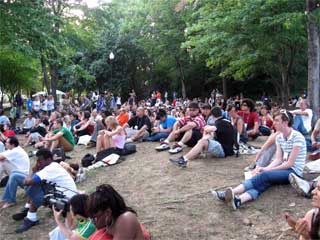 Like Montevideo, Atlanta does not have much for mountains. Cities in general lack beautiful, relaxing, and refreshing green spaces on which I thrive so much. Perhaps it does not make that much difference when one is in a city for a meeting in which too much of the time is spent inside in air controlled spaces. After a march through Atlanta's hot and humid concrete jungle, the first day of the United States Social Forum ended with an opening ceremony in a park behind the civic center. We sat on the grass and listened to music and a couple of speeches.
Like Montevideo, Atlanta does not have much for mountains. Cities in general lack beautiful, relaxing, and refreshing green spaces on which I thrive so much. Perhaps it does not make that much difference when one is in a city for a meeting in which too much of the time is spent inside in air controlled spaces. After a march through Atlanta's hot and humid concrete jungle, the first day of the United States Social Forum ended with an opening ceremony in a park behind the civic center. We sat on the grass and listened to music and a couple of speeches.
 I had forgotten how beautiful southern Mexico was. Or maybe I never really knew? During previous trips to Chiapas I had either been horribly sick or sat under a wet, dreary sky. My only overland trip from Oaxaca to Chiapas was at night. This time the weather was beautiful, and the rock outcroppings above El Nuevo Paraiso across from the massacre site at Acteal were particularly stunning. Of course, I wanted to climb all of these mountains, but the opportunity did not present itself. I was, however, able to visit Palanque--the last major archaeological site in the Americas that I had yet to see. Palenque is best known for the Temple of the Inscriptions where Alberto Ruz famously found an elaborate tomb buried deep in its body. True to form, however, the Temple of the Inscriptions was roped off and I was unable to climb it. All these beautiful mountains; none climbed.
I had forgotten how beautiful southern Mexico was. Or maybe I never really knew? During previous trips to Chiapas I had either been horribly sick or sat under a wet, dreary sky. My only overland trip from Oaxaca to Chiapas was at night. This time the weather was beautiful, and the rock outcroppings above El Nuevo Paraiso across from the massacre site at Acteal were particularly stunning. Of course, I wanted to climb all of these mountains, but the opportunity did not present itself. I was, however, able to visit Palanque--the last major archaeological site in the Americas that I had yet to see. Palenque is best known for the Temple of the Inscriptions where Alberto Ruz famously found an elaborate tomb buried deep in its body. True to form, however, the Temple of the Inscriptions was roped off and I was unable to climb it. All these beautiful mountains; none climbed.